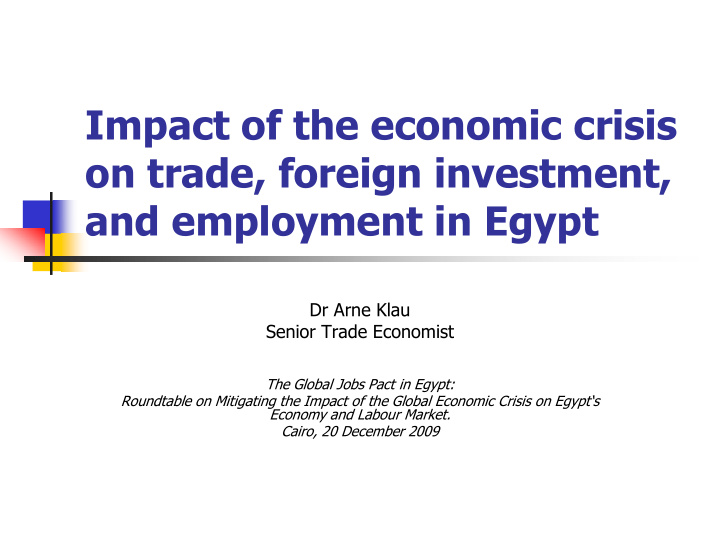



Impact of the economic crisis on trade, foreign investment, and employment in Egypt Dr Arne Klau Senior Trade Economist The Global Jobs Pact in Egypt: Roundtable on Mitigating the Impact of the Global Economic Crisis on Egypt‘s Economy and Labour Market. Cairo, 20 December 2009
Overview 1. The crisis in Egypt – some basic facts 2. Trade policy and trade flows 3. Investment policy and FDI inflows 4. Employment policy and the labour market (1) Labour market challenges before the crisis (2) The labour market during the crisis 5. Outlook and recommendations
1. The crisis in Egypt GDP growth: 7.2% in 2007/08, but 5.8% in Q1 2008/09 and 4.1% in Q2 2008/09 A real sector crisis Consequences: (1) Increase of unemployment (2) Change in the composition of the working age population Transmission channels: (1) Exports (2) FDI inflows (3) Remittances (4) Official transfers
The transmission channels in comparison Decrease of foreign exchange inflows (US$ billion), 2007/08 to 2008/09 6 5 4 3 2 1 0 Merchandise Service FDI inflows Remittances Official exports exports transfers Sources: Central Bank of Egypt, Balance of payments data, CAPMAS (FDI)
Egypt in international comparison Impact of the economic crisis on the value of exports, countries covered by ILO rapid impact assessments (Index, 1 st half of 2007=100) 200 1st 2007 2nd 2007 1st 2008 2nd 2008 1st 2009 180 160 140 120 100 80 60 40 20 0 Egypt Uganda Ukraine South Africa India Brazil Sources: National Authorities, except for Liberia: Eurostat and US International Trade Commission *) Exports to the US and EU only, based on mirror statistics
2. Trade policy and trade flows Egypt is a WTO member Considerable unilateral tariff reduction in 2005 Large network of Free-Trade Agreements: EU (2004), EFTA (2004), GAFTA, Turkey, Comesa QIZ-Agreement with the U.S. and Israel (2005) Little use of contingency measures Problems: high average MFN tariffs remain, complexities in tariff system, customs procedures
2. Trade policy and trade flows Trade liberalization fuelled a strong expansion of trade flows between 2004 and 2008 driven by finished goods, tourism and natural gas falling importance of cotton
Merchandise exports, 2004 and 2008 30000 Finished goods 25000 Semi-finished goods Raw materials 20000 US$ million Raw cotton Natural gas 15000 Crude oil 10000 5000 0 2004 2008
3. Investment policy and FDI inflows Liberal legislation on foreign investment But: problems in the business environment (construction permits, enforcing contracts, hiring and dismissing workers, general ease of doing business)
3. Investment policy and FDI inflow Investment has been the main growth driver between 2004-08 High and growing importance of FDI (2003/4: US$ 0.4 billion, 0.5% of GDP 2007/08: US$ 17.8 billion, 8.1% of GDP) Strong fall of FDI during the crisis: US$ 12.8 billion in 2008/09
4. Employment policy and the labour market Labour market challenges before the crisis (1) A rapidly increasing labour force (2) Low participation of women (3) Over-employment in the public sector (4) A large informal economy (5) Low productivity and wage levels
Labour market challenges before the crisis (6) High unemployment rates, especially for women and the young (7) Mismatches between supply and demand (8) Difficulties for small and medium-sized enterprises (9) Weaknesses in other components of decent work (social dialogue, social protection)
The labour market during the crisis Increase of the unemployment rate from 8.4% (June 2008) to 9.4% (June 2009) But: increase of female unemployment (18.8% to 23.2%) and decrease of male unemployment (5.4% to 5.3%) Low increase of labour force (400,000) Job losses mainly in sectors that are (1) employment-intensive and (2) export- oriented
Contribution to GDP Importance in trade, Employment Estimated crisis impact on Sector in 2007/08 export decline elasticity a employment during crisis Agriculture and food High, some 13% of Limited, as production High, with high Limited, as the sector has industries GDP is mainly for domestic importance of the been sustained by domestic Estimated employment impact of the global crisis, by sector consumption sector for overall demand employment Oil and natural gas High, 16.4% of GDP High, very strong Low Limited, due to low production (incl. refining) declines in export importance for overall revenues employment Textiles and clothing Medium, 2.9% of GDP High, strong declines High High, with massive lay-offs in export revenues Construction Medium, 4.3% of GDP Low High Limited, as the sector has been sustained by domestic demand and is the main beneficiary of the fiscal stimulus package Suez Canal Medium, 3.6% High, strong declines Low Limited due to low overall in export revenues employment Tourism Medium, 3.8% of GDP High, strong declines High High, with massive lay-offs in export revenues Financial services Medium, 4.1% of GDP Limited Medium Limited due to high inward orientation Information and Medium, some 4% of Limited Medium Limited, due to high sectoral communication technology GDP growth
5. Outlook and recommendations Unemployment and adjustment after financial crises Country Pre-crisis Peak unemployment Unemployment back at unemploy- pre-crisis level ment +/- 1% 1 year (time since beginning average of crisis) 1.8 % 5.3% Thailand 2.4% (1997) (3.5 years) 2.4 % 8.5% South Korea 3.2% (1997) (4.75 years) 11.3% 14.3% Russia 12.3% (1998) (1 year) 15.6% 21.5% Argentina 16.3% (2001) (2 years) 4.5% 10.3% Ireland ?? (2008) Egypt 8.4% 9.4% ?? (2008)
5. Outlook and recommendations Improve statistics (quality, timeliness, - transparency) - Further trade liberalization Improvements in the business environment Tackle labour market challenges Successful improvements on both sides (trade and labour markets) will strengthen Egypt’s economy and make it more resilient to crises
Thank you for your attention!
Recommend
More recommend